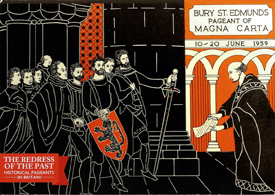- Home
- About Us
- The Great Charter
of Bury St Edmunds - The Magna Carta
- The Pageants
- Events
- Past Events
- Resources and Links
- Photo Gallery
- Rebecca’s Magna Carta Blog
Pageants Exhibition at Moyse’s Hall 4 May to 28 August 2015 FREE

Rebecca’s Magna Carta Blog
What was and is Magna Carta?
On 15th June 1215 King John gave into the demands of his barons detailed in the document that became Magna Carta. But what was Magna Carta and why is it still so important today?
The importance of Magna Carta to Bury St Edmunds is that it is believed by some, especially by the people of Bury St Edmunds, that prior to the barons presenting John with their demands they met at the Abbey in the town to agree on what those demands would be and what their actions would be if he refused them. The evidence for this meeting is in Roger of Wendover’s chronicle, but this is the only mention of it. So the rest of the argument for the meeting is currently based on circumstantial evidence, which I will look at in rest of the blog posts.
For this post, let’s go back to the question of the importance of Magna Carta in its own time and its lasting relevance.
In 1215 it was a peace treaty between King John and his feudal barons as demonstrated by clauses such as clause 51;
“As soon as peace is restored, we will remove from the kingdom all foreign knights, cross-bowmen, sergeants, and mercenaries, who have come with horses and arms to the detriment of the kingdom.”
There is also clause 50 which names specific people, and their families, who the barons felt should be removed from positions of power. Both of these are good examples of how Magna Carta started life as a peace treaty. It was needed because the kingdom was on the verge of civil war, because King John was abusing his power beyond what the barons would bare, but it did not last. King John had the pope declare the document invalid and England was plunged into the civil war that Magna Carta had been designed to avoid. It was reissued after John’s death, again as a form of peace treaty, by William Marshal 1st Earl of Pembroke and regent for Henry III. I’ll tell you more about them in a later blog entry.
It is important to remember that this was a unique document in its time. It was the first time that the barons had forced the king into a written agreement that curtailed his powers; the first time the king was shown to be beneath the law.
Over time the view of Magna Carta changed to the point that it is now seen as the cornerstone of western democracy. Clauses from Magna Carta that lead to this belief include clause 39;
“No free man shall be taken, imprisoned, be stripped of his rights or possessions, or outlawed or exiled, or deprived of his position in any other way, nor will we act or send against him, except by the lawful judgement of his equals or by the law of the land.”
This particular clause created trial by jury which is an important part of the judicial system in not only England but much of the western world. Some of the other clauses still in use today refer to the liberty of the English Church and the liberties of the city of London and all other boroughs. In all there are four clauses that are still a part of life today out of a total of 62 clauses and a summary that made up the original document.
In my next two posts I will start looking at the circumstantial evidence for a meeting at Bury St Edmunds, beginning with the importance of the Abbey in the medieval period.